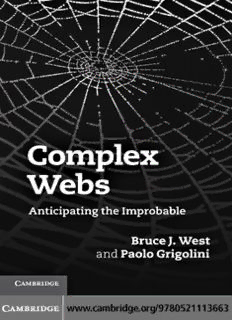
Complex Webs: Anticipating the Improbable PDF
Preview Complex Webs: Anticipating the Improbable
This page intentionally left blank ComplexWebs Complex Webs synthesizes modern mathematical developments with a broad range of complexnetworkapplicationsofinteresttotheengineerandsystemscientist,presenting the common principles, algorithms, and tools governing network behavior, dynamics, and complexity. The authors investigate multiple mathematical approaches to inverse powerlawsandexposethemythofnormalstatisticstodescribenaturalandman-made networks.Richlyillustratedthroughoutwithreal-worldexamplesincludingcellphone use,accessingtheInternet,failureofpowergrids,measuresofhealthanddisease,distri- butionofwealth,andmanyotherfamiliarphenomenafromphysiology,bioengineering, biophysics,andinformationalandsocialnetworks,thisbookmakesthought-provoking reading. With explanations of phenomena, diagrams, end-of-chapter problems, and workedexamples,itisidealforadvancedundergraduateandgraduatestudentsinengi- neering and the life, social, and physical sciences. It is also a perfect introduction for researcherswhoareinterestedinthisexcitingnewwayofviewingdynamicnetworks. BRUCEJ.WESTisChiefScientistMathematicswiththeInformationScienceDirectorate attheArmyResearchOffice,apositionhehasheldforthelast10years.Afterreceiv- ing his Ph.D. in Physics from the University of Rochester in 1970, he was Associate Directorofasmallprivateresearchinstitute(LaJollaInstitute)foralmost20yearsand aProfessorattheUniversityofNorthTexasforadecade.Hisresearchinterestsarein thenonlinear dynamics ofcomplex networks.Hehasover 350scientificpublications, including 11 books and 8,500 citations, and he has received multiple academic and governmentawardsforhisresearchandpublications. PAOLO GRIGOLINI is currently a Professor in the Physics Department and the Center for NonlinearScienceattheUniversityofNorthTexas.Heisaninternationallyrecognized theorist interested in the foundations of quantum mechanics, including wave-function collapse and the influence of classical chaos on quantum systems. His other research interests include the foundations of statistical physics, biophysical problems such as DNAsequencing,andthenetworkscienceofhumandecisionmakingandcognition. Complex Webs Anticipating the Improbable BRUCE J. WEST ArmyResearchOffice,USA PAOLO GRIGOLINI UniversityofNorthTexas CAMBRIDGEUNIVERSITYPRESS Cambridge,NewYork,Melbourne,Madrid,CapeTown,Singapore, SãoPaulo,Delhi,Dubai,Tokyo,MexicoCity CambridgeUniversityPress TheEdinburghBuilding,CambridgeCB28RU,UK PublishedintheUnitedStatesofAmericabyCambridgeUniversityPress,NewYork www.cambridge.org Informationonthistitle:www.cambridge.org/9780521113663 (cid:2)c B.J.WestandP.Grigolini2011 Thispublicationisincopyright.Subjecttostatutoryexception andtotheprovisionsofrelevantcollectivelicensingagreements, noreproductionofanypartmaytakeplacewithoutthewritten permissionofCambridgeUniversityPress. Firstpublished2011 PrintedintheUnitedKingdomattheUniversityPress,Cambridge AcatalogrecordforthispublicationisavailablefromtheBritishLibrary ISBN978-0-521-11366-3Hardback CambridgeUniversityPresshasnoresponsibilityforthepersistenceor accuracyofURLsforexternalorthird-partyinternetwebsitesreferredto inthispublication,anddoesnotguaranteethatanycontentonsuch websitesis,orwillremain,accurateorappropriate. Contents Preface pageix 1 Webs 1 1.1 Themythofnormalcy 1 1.1.1 Knowledge,informationanduncertainty 8 1.1.2 Maximumentropy 14 1.2 Empiricallaws 21 1.3 Whypeopleforecastsareusuallywrong 34 1.3.1 Powerlaws,predictionandfailure 38 1.4 Recap 41 1.5 Problems 42 References 43 2 Webs,treesandbranches 45 2.1 Naturaltreesandscaling 50 2.1.1 Twokindsofscaling 52 2.1.2 Physiologictrees 59 2.2 Physiologyinfractaldimensions 65 2.2.1 Fractals 66 2.2.2 Temporalscaling 74 2.2.3 Autocorrelationfunctionsandfractaldimensions 77 2.3 Measuringwhatwecannotknowexactly 79 2.3.1 InversepowerlawsofZipfandPareto 80 2.3.2 Chaos,noiseandprobability 85 2.4 Scalingphysiologictimeseries 88 2.4.1 Fractalheartbeats 89 2.4.2 Fractalbreaths 92 2.4.3 Fractalsteps 94 2.5 Someafterthoughts 98 2.6 Problems 99 References 100 vi Contents 3 Mostlylineardynamics 105 3.1 Hamilton’sequations 107 3.2 Linearstochasticequations 114 3.2.1 Classicaldiffusion 118 3.2.2 Linearresponsetheory(LRT) 124 3.2.3 Double-wellpotentialandstochasticresonance 127 3.3 Moreonclassicaldiffusion 130 3.3.1 TheFokker–Planckequation(FPE) 133 3.3.2 Thedrift-diffusionmodel(DDM)ofdecisionmaking 137 3.3.3 First-passage-timedistributions 142 3.4 Moreonstatistics 144 3.4.1 Poissonstatistics 145 3.4.2 Statisticswithmemory 147 3.4.3 Inversepower-lawcorrelations 148 3.5 MovingfromHamiltonianstoevents 153 3.5.1 Age-specificfailurerates 153 3.5.2 Possibleformsoffailurerates 155 3.5.3 VariousPoissonprocesses 158 3.6 Overview 161 3.7 Problems 162 References 163 4 Randomwalksandchaos 166 4.1 Randomwalks 168 4.1.1 Simplerandomwalks 169 4.1.2 Poissonwebs 174 4.2 Fractalrandomwalks 177 4.2.1 TheWeierstrasswalk 178 4.2.2 Lévyrandomflights 180 4.2.3 Fractionaloperatorwalk 183 4.3 Maps,chaosandstrangeattractors 188 4.3.1 Thelogisticequation 190 4.3.2 Strangeattractors 198 4.4 Integrableandnon-integrableHamiltonians 202 4.4.1 Thesurfaceofsection 205 4.4.2 Chaosandlinearresponsetheory 208 4.5 Précis 219 4.6 Problems 220 References 221 5 Non-analyticdynamics 224 5.1 Transitiontofractionaldynamics 225 Contents vii 5.1.1 Fractionalcalculus 228 5.1.2 Deterministicfractionaldynamics 231 5.2 Someapplications 234 5.2.1 ThefractionalPoissondistribution 234 5.2.2 TheWeibulldistribution 236 5.3 Fractionalstochasticequations 237 5.3.1 ThefractionalLangevinequation 237 5.3.2 Multiplicativerandomforce 239 5.3.3 Somephysiologicmultifractals 242 5.4 Spatialheterogeneity 247 5.4.1 Randomfields 247 5.4.2 Continuous-timerandomwalks(CTRWs) 250 5.4.3 Infinitemoments 254 5.4.4 Scalingsolutions 257 5.5 Reiteration 258 5.6 Problems 259 References 259 6 Abriefrecenthistoryofwebs 262 6.1 Webgrowth 264 6.1.1 Scale-freewebs 265 6.1.2 Communicationwebs 268 6.2 Graphicpropertiesofwebs 275 6.2.1 Randomwebs 277 6.2.2 Realwebs 286 6.2.3 Webfailures 294 6.3 Deterministicwebmodels 297 6.3.1 Hierarchalwebs 297 6.3.2 Fromsmalltoultra-smallnetworks 301 6.4 Reflections 303 6.5 Problems 304 References 305 7 Dynamicsofchance 307 7.1 Themasterequation 308 7.1.1 Discretedynamics 309 7.1.2 Asynchronizedweboftwo-levelnodes 310 7.1.3 Stochasticapproximationtoasynchronizedweb 314 7.1.4 TheYuleprocess 317 7.2 Generalmodelingstrategy 319 7.2.1 FromcrucialeventstotheGME 319 7.2.2 Relaxationofthetwo-levelGME 322 7.2.3 PerturbingtheGME 323 viii Contents 7.2.4 TowardsanewLRT 326 7.2.5 StochasticresonanceandconventionalLRT 327 7.3 TheUniversalityofLRT 331 7.3.1 TheHamiltonianapproachtoLRT 332 7.3.2 Applyingtheformalism 334 7.3.3 Theexperimentalapproach 336 7.3.4 Theoreticalinterpretation 340 7.4 Thestatisticalhabituationmodel(SHM) 344 7.4.1 Simplestimulusandrenewaltheory 346 7.4.2 Informationresonanceanddishabituation 348 7.4.3 Discussion 349 7.5 Summary 351 7.6 Problems 352 References 353 8 Synopsis 357 References 363 Index 365
Description: